Related Research Articles

HE0107-5240 is an extremely metal-poor Population II star, located roughly 36000 light-years away from Earth. It is one of the most metal-poor stars known in our Galaxy, with a metallicity [Fe/H] = −5.2±0.2; i.e. it has just 1/160000 of the metal that the Sun has. Because of its very low metallicity, it is believed to be one of the earliest Population II stars to have formed. If so, then it is also very old, with an age of roughly 13 billion years. Because the star is not completely metal-free, it does not belong to the first generation of stars. These stars converted the pristine hydrogen, helium, and lithium formed by the Big Bang into heavier elements, such as carbon, oxygen, and metals.

In 1944, Walter Baade categorized groups of stars within the Milky Way into stellar populations. In the abstract of the article by Baade, he recognizes that Jan Oort originally conceived this type of classification in 1926.
A carbon star is typically an asymptotic giant branch star, a luminous red giant, whose atmosphere contains more carbon than oxygen. The two elements combine in the upper layers of the star, forming carbon monoxide, which consumes most of the oxygen in the atmosphere, leaving carbon atoms free to form other carbon compounds, giving the star a "sooty" atmosphere and a strikingly ruby red appearance. There are also some dwarf and supergiant carbon stars, with the more common giant stars sometimes being called classical carbon stars to distinguish them.

A subdwarf, sometimes denoted by "sd", is a star with luminosity class VI under the Yerkes spectral classification system. They are defined as stars with luminosity 1.5 to 2 magnitudes lower than that of main-sequence stars of the same spectral type. On a Hertzsprung–Russell diagram subdwarfs appear to lie below the main sequence.
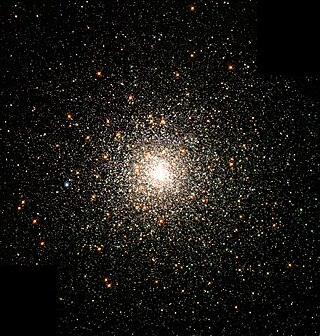
In astronomy, metallicity is the abundance of elements present in an object that are heavier than hydrogen and helium. Most of the normal currently detectable matter in the universe is either hydrogen or helium, and astronomers use the word "metals" as a convenient short term for "all elements except hydrogen and helium". This word-use is distinct from the conventional chemical or physical definition of a metal as an electrically conducting solid. Stars and nebulae with relatively high abundances of heavier elements are called "metal-rich" in astrophysical terms, even though many of those elements are nonmetals in chemistry.

The Sculptor Dwarf Galaxy is a dwarf spheroidal galaxy that is a satellite of the Milky Way. The galaxy lies within the constellation Sculptor. It was discovered in 1937 by American astronomer Harlow Shapley using the 24-inch Bruce refractor at Boyden Observatory. The galaxy is located about 290,000 light-years away from the Solar System. The Sculptor Dwarf contains only 4 percent of the carbon and other heavy elements in our own galaxy, the Milky Way, making it similar to primitive galaxies seen at the edge of the universe.

HE 1327-2326, discovered in 2005 by Anna Frebel and collaborators, was the star with the lowest known iron abundance until SMSS J031300.36−670839.3 was discovered. The star is a member of Population II stars, with a solar-standardised iron to hydrogen index [Fe/H], or metallicity, of −5.4±0.2. The scale being logarithmic, this number indicates that its iron content is about 1/250000 that of the Earth's sun. However, it has a carbon abundance of roughly one-tenth solar, and it is not known how these two abundances can have been produced/exist simultaneously. Discovered by the Hamburg/ESO survey for metal-poor stars, it was probably formed during an age of the universe when the metal content was much lower. It has been speculated that this star is part of the second generation, born out of the gas clouds which were imbued with elements such as carbon by the primordial Population III stars.
BPS CS22892-0052 is an old population II star located at a distance of 4.7 kiloparsecs in the Milky Way's galactic halo. It belongs to a class of ultra-metal-poor stars, specifically the very rare subclass of neutron-capture (r-process) enhanced stars. It was discovered by Tim C. Beers and collaborators with the Curtis Schmidt telescope at the Cerro Tololo Inter-American Observatory in Chile. Extended high-resolution spectroscopic observations since around 1995 allowed observers to determine the abundances of 53 chemical elements in this star, as of December 2005 only second in number to the Sun.
Canes Venatici I or CVn I is a dwarf spheroidal galaxy situated in the Canes Venatici constellation and discovered in 2006 in the data obtained by Sloan Digital Sky Survey. It is one of the most distant known satellites of the Milky Way as of 2011 together with Leo I and Leo II. The galaxy is located at a distance of about 220 kpc from the Sun and is moving away from the Sun at a velocity of about 31 km/s. It is classified as a dwarf spheroidal galaxy (dSph) meaning that it has an elliptical shape with the half-light radius of about 550 pc.
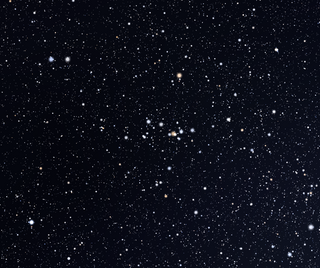
DY Persei is a variable star and carbon star in the Perseus constellation. At maximum it is 11th magnitude and at its faintest it drops to 16th magnitude. DY Persei is the prototype of the very rare DY Persei class of variables that pulsate like red variables but also fade from sight like R Coronae Borealis variables.
Ursa Major II Dwarf is a dwarf spheroidal galaxy situated in the Ursa Major constellation and discovered in 2006 in the data obtained by the Sloan Digital Sky Survey. The galaxy is located approximately 30 kpc from the Sun and moves towards the Sun with the velocity of about 116 km/s. It has an elliptical shape with the half-light radius of about 140 pc.
Leo T is a dwarf galaxy situated in the Leo constellation and discovered in 2006 in the data obtained by Sloan Digital Sky Survey. The galaxy is located at the distance of about 420 kpc from the Sun and moves away from the Sun with the velocity of about 35 km/s. The velocity with respect to the Milky Way is around −60 km/s implying a slow infall onto the Milky Way. Leo T is classified as a transitional object between dwarf spheroidal galaxies (dSph) and dwarf irregular galaxies (dIrr). Its half-light radius is about 180 pc.

A subdwarf O star (sdO) is a type of hot, but low-mass star. O-type subdwarfs are much dimmer than regular O-type main-sequence stars, but with a brightness about 10 to 100 times that of the Sun, and have a mass approximately half that of the Sun. Their temperature ranges from 40,000 to 100,000 K. Ionized helium is prominent in their spectra. Gravity acceleration is expressed by log g between 4.0 and 6.5. Many sdO stars are moving at high velocity through the Milky Way and are found at high galactic latitudes.
The metallicity distribution function is an important concept in stellar and galactic evolution. It is a curve of what proportion of stars have a particular metallicity of a population of stars such as in a cluster or galaxy.

In astrobiology and planetary astrophysics, the galactic habitable zone is the region of a galaxy in which life might most likely develop. The concept of a galactic habitable zone analyzes various factors, such as metallicity and the rate and density of major catastrophes such as supernovae, and uses these to calculate which regions of a galaxy are more likely to form terrestrial planets, initially develop simple life, and provide a suitable environment for this life to evolve and advance. According to research published in August 2015, very large galaxies may favor the birth and development of habitable planets more than smaller galaxies such as the Milky Way. In the case of the Milky Way, its galactic habitable zone is commonly believed to be an annulus with an outer radius of about 10 kiloparsecs (33,000 ly) and an inner radius close to the Galactic Center.
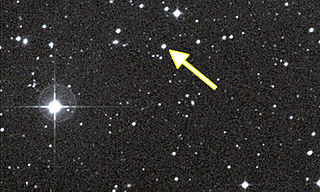
SMSS J031300.36−670839.3 is a star in the Milky Way at a distance of 6,000 ly (1,800 pc) from Earth. With an age of approximately 13.6 billion years, it is one of the oldest stars known. Another star, HD 140283, was considered to be older, but there is uncertainty in values of its age. This makes SM0313 the oldest known star with an accurate determination of its age. The star formed only about 100 million years after the Big Bang and has been shining for 13.6 billion years. The star's very low upper limit of iron of less than one ten-millionth the iron level of the Sun, suggests that it is one of the first Population II stars, formed from a gas cloud enriched by some of the first stars. SMSS J031300.36-670839.3 also has a much higher carbon supply compared to iron, more than a thousand times greater. Apart from hydrogen, which appeared in the Big Bang, the star also contains carbon, magnesium, and calcium, which could have been formed in a low-energy supernova. Methylidyne (CH) is also detected by its absorption line. No oxygen or nitrogen has been detected. The star is a K-class red giant.
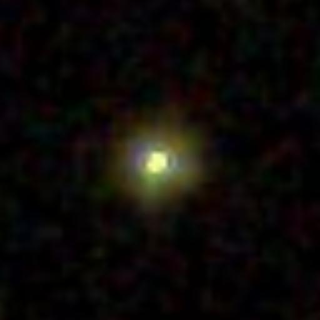
SDSS J001820.5–093939.2 or SDSS J0018−0939 for short is a star system approximately 1000 light-years away near the constellation Cetus.

Timothy C. Beers is an American astrophysicist. Beers teaches at the University of Notre Dame in the Department of Physics (2014–present), where he holds the Notre Dame Chair in Astrophysics. He is a co-founder of the Physics Frontier Center Joint Institute for Nuclear Astrophysics – Center for the Evolution of the Elements. Prior to coming to Notre Dame, Beers was Director of Kitt Peak National Observatory (2011-2014), and for 25 years was a professor in the Department of Physics and Astronomy at Michigan State University (1986-2011), retiring from that position as University Distinguished Professor.
2MASS J18082002−5104378 is an ultra metal-poor (UMP) binary star system, in the constellation Ara, about 1,950 ly (600 pc) from Earth, and is a single-lined spectroscopic binary (SB1). It is one of the oldest stars known, about 13.53 billion years old, possibly one of the first stars, a star made almost entirely of materials released from the Big Bang. A tiny unseen companion, a low-mass UMP star, is particularly unusual.
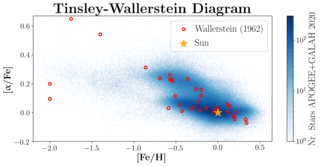
The [α/Fe] versus [Fe/H] diagram refers to the graph, commonly used in stellar and galactic astrophysics. It shows the logarithmic ratio number densities of diagnostic elements in stellar atmospheres compared to the solar value. The x-axis represents the abundance of iron (Fe) vs. hydrogen (H), that is, [Fe/H]. The y-axis represents the combination of one or several of the alpha process elements compared to iron (Fe), denoted as [α/Fe].
References
- 1 2 3 4 5 6 7 8 Catherine r. Kennedy (29 May 2014). "Carbon-Enhanced Metal-Poor Stars in the Milky Way" (PDF). Canberra. Archived from the original (PDF) on October 19, 2015. Retrieved 18 December 2016.
- ↑ Carollo, Daniela; Freeman, Ken; Beers, Timothy; Placco, Vinicius; Tumlinson, Jason; Martell, Sarah (20 June 2014). "Carbon-Enhanced Metal-Poor Stars: CEMP-s and CEMP-no Sub-Classes in the Halo System of the Milky Way". The Astrophysical Journal. 788 (2): 180. arXiv: 1401.0574 . Bibcode:2014ApJ...788..180C. doi:10.1088/0004-637X/788/2/180. S2CID 59932382.